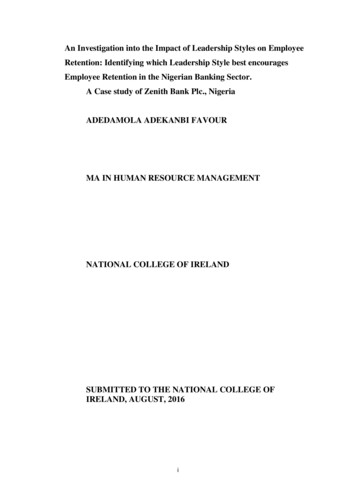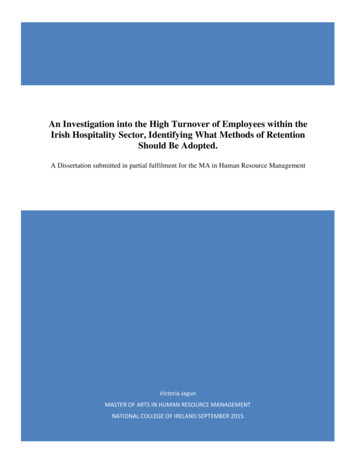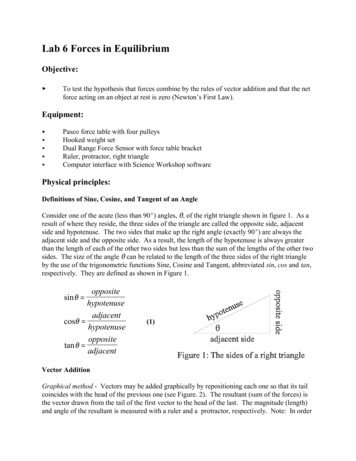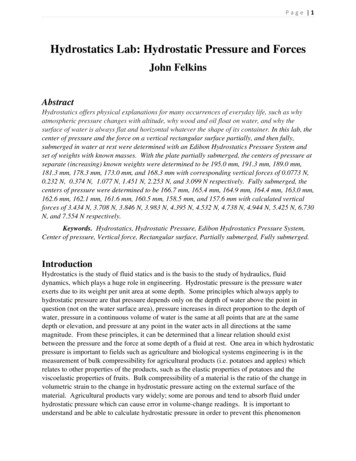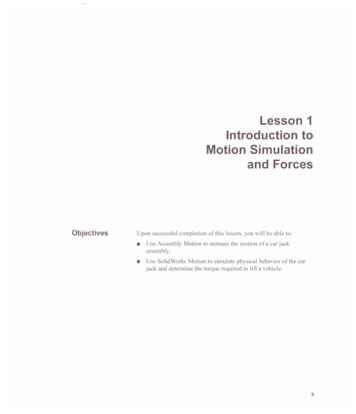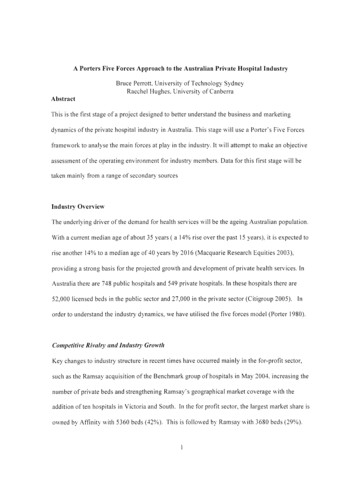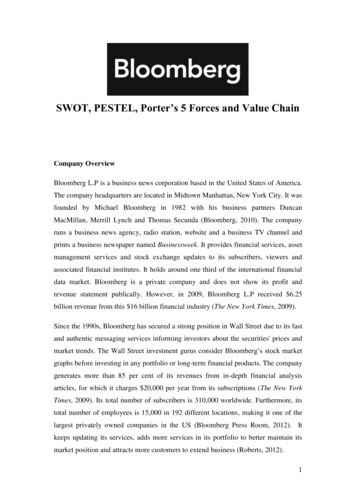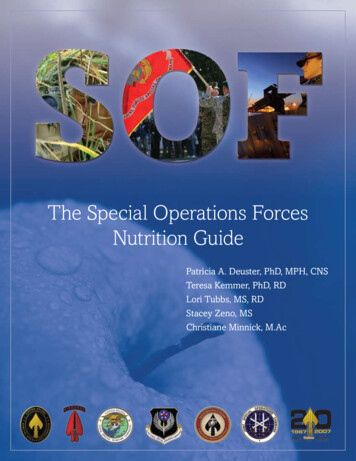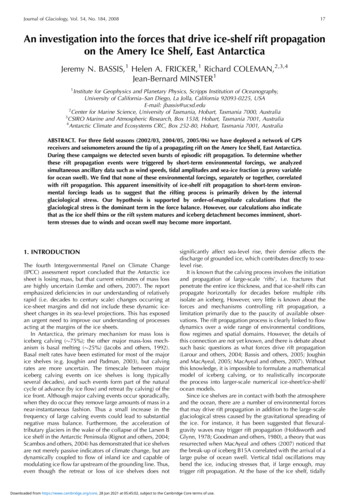
Transcription
Journal of Glaciology, Vol. 54, No. 184, 200817An investigation into the forces that drive ice-shelf rift propagationon the Amery Ice Shelf, East AntarcticaJeremy N. BASSIS,1 Helen A. FRICKER,1 Richard COLEMAN,2,3,4Jean-Bernard MINSTER11Institute for Geophysics and Planetary Physics, Scripps Institution of Oceanography,University of California–San Diego, La Jolla, California 92093-0225, USAE-mail: jbassis@ucsd.edu2Center for Marine Science, University of Tasmania, Hobart, Tasmania 7000, Australia3CSIRO Marine and Atmospheric Research, Box 1538, Hobart, Tasmania 7001, Australia4Antarctic Climate and Ecosystems CRC, Box 252-80, Hobart, Tasmania 7001, AustraliaABSTRACT. For three field seasons (2002/03, 2004/05, 2005/06) we have deployed a network of GPSreceivers and seismometers around the tip of a propagating rift on the Amery Ice Shelf, East Antarctica.During these campaigns we detected seven bursts of episodic rift propagation. To determine whetherthese rift propagation events were triggered by short-term environmental forcings, we analyzedsimultaneous ancillary data such as wind speeds, tidal amplitudes and sea-ice fraction (a proxy variablefor ocean swell). We find that none of these environmental forcings, separately or together, correlatedwith rift propagation. This apparent insensitivity of ice-shelf rift propagation to short-term environmental forcings leads us to suggest that the rifting process is primarily driven by the internalglaciological stress. Our hypothesis is supported by order-of-magnitude calculations that theglaciological stress is the dominant term in the force balance. However, our calculations also indicatethat as the ice shelf thins or the rift system matures and iceberg detachment becomes imminent, shortterm stresses due to winds and ocean swell may become more important.1. INTRODUCTIONThe fourth Intergovernmental Panel on Climate Change(IPCC) assessment report concluded that the Antarctic icesheet is losing mass, but that current estimates of mass lossare highly uncertain (Lemke and others, 2007). The reportemphasized deficiencies in our understanding of relativelyrapid (i.e. decades to century scale) changes occurring atice-sheet margins and did not include these dynamic icesheet changes in its sea-level projections. This has exposedan urgent need to improve our understanding of processesacting at the margins of the ice sheets.In Antarctica, the primary mechanism for mass loss isiceberg calving ( 75%); the other major mass-loss mechanism is basal melting ( 25%) (Jacobs and others, 1992).Basal melt rates have been estimated for most of the majorice shelves (e.g. Joughin and Padman, 2003), but calvingrates are more uncertain. The timescale between majoriceberg calving events on ice shelves is long (typicallyseveral decades), and such events form part of the naturalcycle of advance (by ice flow) and retreat (by calving) of theice front. Although major calving events occur sporadically,when they do occur they remove large amounts of mass in anear-instantaneous fashion. Thus a small increase in thefrequency of large calving events could lead to substantialnegative mass balance. Furthermore, the acceleration oftributary glaciers in the wake of the collapse of the Larsen Bice shelf in the Antarctic Peninsula (Rignot and others, 2004;Scambos and others, 2004) has demonstrated that ice shelvesare not merely passive indicators of climate change, but aredynamically coupled to flow of inland ice and capable ofmodulating ice flow far upstream of the grounding line. Thus,even though the retreat or loss of ice shelves does notsignificantly affect sea-level rise, their demise affects thedischarge of grounded ice, which contributes directly to sealevel rise.It is known that the calving process involves the initiationand propagation of large-scale ‘rifts’, i.e. fractures thatpenetrate the entire ice thickness, and that ice-shelf rifts canpropagate horizontally for decades before multiple riftsisolate an iceberg. However, very little is known about theforces and mechanisms controlling rift propagation, alimitation primarily due to the paucity of available observations. The rift propagation process is clearly linked to flowdynamics over a wide range of environmental conditions,flow regimes and spatial domains. However, the details ofthis connection are not yet known, and there is debate aboutsuch basic questions as what forces drive rift propagation(Larour and others, 2004; Bassis and others, 2005; Joughinand MacAyeal, 2005; MacAyeal and others, 2007). Withoutthis knowledge, it is impossible to formulate a mathematicalmodel of iceberg calving, or to realistically incorporatethe process into larger-scale numerical ice-sheet/ice-shelf/ocean models.Since ice shelves are in contact with both the atmosphereand the ocean, there are a number of environmental forcesthat may drive rift propagation in addition to the large-scaleglaciological stress caused by the gravitational spreading ofthe ice. For instance, it has been suggested that flexuralgravity waves may trigger rift propagation (Holdsworth andGlynn, 1978; Goodman and others, 1980), a theory that wasresurrected when MacAyeal and others (2007) noticed thatthe break-up of iceberg B15A correlated with the arrival of alarge pulse of ocean swell. Vertical tidal oscillations maybend the ice, inducing stresses that, if large enough, maytrigger rift propagation. At the base of the ice shelf, tidallyDownloaded from https://www.cambridge.org/core. 28 Jun 2021 at 05:45:02, subject to the Cambridge Core terms of use.
18Bassis and others: Forces that drive rift propagationFig. 2. Diagram showing the relative positions of observing stations(gray triangles) relative to the tip of rift T2 (gold star) for seasons 2and 3. Different stations and a different geometry were used for season 1. However, the network was centered on the rift tip each season.Fig. 1. (a) MODIS (moderate-resolution imaging spectroradiometer)image acquired on 18 January 2006 showing the Amery Ice Shelfand the ‘Loose Tooth’ rift system. White squares show the positionof the three ice-shelf-based AWS sites, AM01, AM02 and G3.(b) Line map showing the location of the Amery Ice Shelf in EastAntarctica. The tide gauge was located at Davis. (c) Landsat imageacquired on 18 December 2002 showing a close-up of theLoose Tooth rift system. The L1–T1–T2 triple junction was firstobserved in 1995. Since then L1 has widened but has not increasedin length.driven sub-ice-shelf currents exert a drag force which couldinduce propagation. At the ice-shelf surface, the cold denseair from katabatic winds (blowing down onto the ice shelfand across the rift) combined with large Antarctic stormsystems can produce large wind fields that also result insubstantial frictional drag force. When either of these twodrag forces (basal or surface) is integrated over a largeenough area, it may result in a substantial stress applied tothe ice shelf. In addition to the above variables that directlyexert a stress on the ice shelf, there are variables thatindirectly modulate the stress. The presence of sea ice, forexample, will dampen the amplitude of ocean swell(Wadhams, 2000), and above-freezing atmospheric temperatures may promote hydro-fracturing of the ice via theproduction of surface melt (Scambos and others, 2003; Alleyand others, 2005).Thus the crucial first step in improving our knowledge oficeberg calving is identifying which force(s) are responsiblefor driving rift propagation. To achieve this, we deployed adensely spaced network of seismometers and global positioning system (GPS) receivers around the tip of a propagating rift on the Amery Ice Shelf, East Antarctica, for threeaustral summer field seasons (Bassis and others, 2005,2007). Our observing network was supplemented by automatic weather stations (AWS) and tide gauges operated bythe Australian Antarctic Division (AAD). This instrumentation provided us with ancillary observations of relevantenvironmental variables, against which we could compareour network data. We augment the field component of thisstudy with a time series of satellite-derived rift lengthspublished by Fricker and others (2005) and extendedthrough 2006. These data provide additional informationabout the rift propagation rate on longer timescales (monthlyand longer).2. AMERY ICE SHELF RIFT-MONITORINGPROGRAM (2003–07)2.1. Location of study and instrumentationOur field study was designed to monitor a system of rifts thathave formed near the front of the Amery Ice Shelf (Fig. 1).The rift system consists of two longitudinal-to-flow rifts 30 km apart that initiated about 20 years ago (L1 and L2)and two transverse-to-flow rifts (T1 to the west and T2 to theeast) that initiated at the tip of L1, forming a triple junctionfirst observed in 1996 (Fricker and others, 2002). This riftsystem forms the outline of an intermediate-sized iceberg(30 km by 30 km), termed the ‘Loose Tooth’, that is expectedto detach within the next decade. Rift T2 currently propagates at approximately 4 m d–1, and when T2 connects withL2, the Loose Tooth iceberg will likely detach.Our field site was located near the tip of T2, where wedeployed a network of seismometers and GPS receiversduring each austral summer season. The geometry of onesuch deployment is shown in Figure 2. Although our instrumentation and network geometry varied each season, thecenter of the network was translated to correspond to theapproximate location of the rift tip observed in the field. In2002/03 we deployed eight stations which acquired data for42 days: six with a single-component L-4C seismometerrecording at 10 Hz (0.1 s) and a dual-frequency GPS receiverrecording at 0.033 Hz (30 s), and two seismometer-onlystations. In 2004/05 and 2005/06 we increased the numberof stations to twelve, each with a three-component L-28seismometer, digitized with a Quanterra Q330 data loggerand a dual-frequency GPS receiver recording at 0.5 Hz (2 s)for 52 and 81 days respectively. Hereafter we refer to thethree field seasons as follows: 2002/03 is ‘season 1’; 2004/05 is ‘season 2’; 2005/06 is ‘season 3’. To facilitate comparison of timing between field seasons, we reference daysof our survey relative to day of year (DOY) 332. In additionto our observing stations, the AAD operated AWS on theAmery Ice Shelf, one located 100 km upstream from ournetwork (shown in Fig. 1).2.2. Previous resultsFieldworkWe have previously shown that over the three field seasonsof our measurements we detected seven bursts of riftpropagation: three during season 1, three during season 2Downloaded from https://www.cambridge.org/core. 28 Jun 2021 at 05:45:02, subject to the Cambridge Core terms of use.
Bassis and others: Forces that drive rift propagation19Fig. 3. Comparison of the amplitudes of winds, tides and atmospheric temperature with the timing of seismic swarms for all three fieldseasons: season 1 (a, d, g, j); season 2 (b, e, h, k); and season 3 (c, f, i, l). (a–c) Atmospheric temperature determined from AWS AM01 andAM02 (see Fig. 1 for locations) for each field season. (d–f) Tidal amplitudes computed from the CATS02.01 tidal model (Padman and others,2002) for each field season. (g–i) Wind speeds measured at AWS AM01 and AM02 for each field season. (j–l) Histogram of rift-relatedseismicity. N is the number of events per bin (bin size 3 hours). The seven propagation events that we observed are labeled and highlightedwith gray shaded boxes. Note the difference in scales between season 1 and seasons 2 and 3. An increase in the number of seismometersand their sampling rate increased the sensitivity to icequakes by more than an order of magnitude.and one during season 3 (Bassis and others, 2005, 2007).Each burst, deduced from swarms of rift-related ‘icequakes’(detected by our seismic network) coincident with rapid riftwidening (detected with our GPS receiver network), lastedapproximately 1–4 hours (Fig. 3j–l). Swarms consisted ofapproximately 10–100 times the background number oficequakes. In between swarms, the background rate of icequake production was relatively constant. Our hypothesisthat the bursts of propagation were caused by episodic riftpropagation was reinforced by the pattern of event locations,which showed that the icequakes were tightly clusteredalong the rift axis near the rift tip.in the austral summer period (September–April) than in thewinter period (April–September). Images are not availableduring winter since the lack of solar illumination preventsimage acquisition. We use an extended time series (throughto 2006) in this paper (Fig. 4, lower panels). Figure 4 showsthe satellite-derived change in rift length L over fivesummer periods from 2001/02 through 2005/06. For eachsummer, we define the change in rift length ( L) as theamount the rift lengthened since the last measurement of theprevious summer, i.e. the first point shows how much the riftlengthened over the winter. It is clear that for most years themajority of rift propagating occurs during the austral summer(Fricker and others, 2005).Satellite observationsOn longer timescales, analysis of rift propagation rates usingmulti-year satellite imagery has provided evidence ofseasonal variability in rift propagation rates (Fricker andothers, 2005). In that paper, satellite images from the Multiangle Imaging Spectroradiometer (MISR) acquired from1999 to 2004 were used to show that rifts lengthen more3. FORCES THAT MAY DRIVE RIFT PROPAGATION3.1. Force balanceWe seek to determine whether short-term variations in thestate of stress trigger the observed rift propagation events.(Short-term, in the context of this study, is defined asDownloaded from https://www.cambridge.org/core. 28 Jun 2021 at 05:45:02, subject to the Cambridge Core terms of use.
20Bassis and others: Forces that drive rift propagationFig. 4. Upper panel: Average sea-ice fraction over a 100 km region in front of the Amery Ice Shelf. Sea-ice fraction was determined from theNCEP MMAB sea-ice model. Lower panel: Change in rift length ( L) over each austral summer field season. L for each season is defined asthe difference between the rift length at time ti and the length of the rift at the end of the previous season. Gray bars show the timing andduration of each field season.monthly or shorter.) Since the ice shelf is influenced by bothinternal and external environmental variables, we perform aforce balance on a unit area of the ice shelf (see, e.g.,Wadhams, 2000): i aHi ¼ a þ w þ tide þ swell þ i þ t þ c ,ð1Þwhere Hi , i , a are the ice thickness, density and acceleration, a is the drag on the ice surface caused by the winds, w is the drag stress due to ocean currents on the bottom ofthe ice shelf, tide and swell are the bending stresses withinthe ice induced by tides and ocean swell, i is theglaciological stress of the ice, c is the Coriolis force and tis the stress induced by slopes of the sea surface. Once theiceberg completely detaches and drifts freely, inertial termsmay become significant. However, our interest is in theperiod prior to detachment when inertial terms can beneglected because of the low ice velocity, so we set thelefthand side of Equation (1) to zero. In addition to thesevariables that directly transmit a force to the ice shelf, sea-iceconcentration and atmospheric temperature may indirectlyFig. 5. Wind speed vs tidal amplitude for all seven propagationevents. Both wind speed and tidal amplitude were obtained fromthe 3 hour average over the duration of the swarm. Uncertaintiesrepresent the standard deviation of values in a 3 hour windowaround the onset of the swarm. The large scatter in the dataindicates that propagation events do not occur at times of high tidalamplitude, severe winds or even a combination of high tidalamplitude and severe winds.affect the force balance by damping the amplitude of oceanswell and promoting meltwater-assisted hydro-fracturing,respectively.3.2. MeasurementsTo evaluate the sensitivity of rift propagation to variations inenvironmental stresses, we considered the relationshipbetween rift propagation events and each of the environmental parameters on the righthand side in Equation (1):Wind speed. We compared the timing of the riftpropagation events with wind speeds measured bynearby ice-shelf-based AWS (AM01 and AM02) operatedby the AAD (personal communication from M. Cravenand I. Allison, 2007). We also examined the effect oflonger-term mean wind fields by comparing variations inrift propagation rates to the mean wind speed, alsodetermined using data from the AWS.Tidal amplitude. We compared the timing of the riftpropagation events with the phase and amplitude of thetide, computed using the CATS02.01 tidal model (Padman and others, 2002) and measured directly with ourGPS. Because the currents are phase-locked to theamplitude of the tides, by determining if there is arelationship between the phase of the tide and propagation events we can also determine if tidally inducedocean currents drive rift propagation.Ocean swell. Since satellite- and model-derived waveheights lack the combination of spatial and temporalresolution required to resolve the amplitude and periodof ocean swell for each propagation event, we do nothave direct information about the amplitude and periodof the wave field in front of the ice shelf. Instead, we useda proxy variable for ocean swell, sea-ice fraction,determined using the US National Centers for Environmental Prediction/Marine Modeling and Analysis Branch(NCEP MMAB) sea-ice model (http://polar.ncep.noaa.gov/seaice/). The presence of sea-ice will attenuatethe amplitude of ocean swell, so a higher sea-ice fractionimplies lower ocean swell amplitude. We compared(1) the timing of the rift propagation events and (2) riftpropagation rates with sea-ice fraction.Downloaded from https://www.cambridge.org/core. 28 Jun 2021 at 05:45:02, subject to the Cambridge Core terms of use.
Bassis and others: Forces that drive rift propagation21Fig. 6. Rift propagation rates (dL/dt ) determined for the September–January and January–April periods against: (a) average wind speed;(b) mean sea-ice fraction; (c) mean temperature. The dashed line indicates the mean of rift propagation rates. There is no correlation betweenrift propagation rates and any of the variables.We neglect both the Coriolis force ( c ) and the sea surfacetilt ( t ) in our analysis because we expect both of these termsto be small in comparison to the other terms in the forcebalance. We examine this assumption in more detail insection 5.2. Since our observing stations during season 2were deployed several weeks prior to the 26 December2004 Sumatra earthquake and the tsunami it generated, wewere able to investigate if the tsunami triggered a riftpropagation event. We compared the timing of the riftpropagation events with the time of arrival of (1) surfacewaves from the earthquake (detected with our seismometers)or (2) the arrival of the tsunami (detected with our GPS andtide gauges operating at Davis station).The final environmental variable we consider is atmospheric temperature. To assess whether variations in temperature modulate rift propagation rates, we compared (1) thetiming of rift propagation events with AWS-derived atmospheric temperatures and (2) variations in rift propagationrates with mean temperature. On the Amery Ice Shelf,longer-term variations in temperature and meltwater production may be more significant factors than the short-termvariations that are the focus of this study.4. RESULTS4.1. Wind speed and tidal amplitudeFigure 3 shows the time series of seismicity, wind speed andtidal amplitude determined using the CATS02.01 tidalmodel for seasons 1, 2 and 3, with the times of the sevenrift propagation events overlain (shaded rectangles). Events 2and 3 in season 1 were preceded by periods of severewinds. However, this relationship does not hold for any ofthe other events. For instance, all of the events duringseason 2
driven sub-ice-shelf currents exert a drag force which could induce propagation. At the ice-shelf surface, the cold dense
